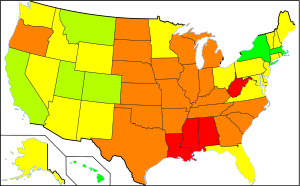
Obesity: A Growing Epidemic
The Center for Disease Control (CDC) states that obesity is a significant public health problem. The "Healthy People" initiative shows that not one state in the United States meets the Healthy People goal of 15% body mass index (BMI).
Thirty states missed the goal by a percentage by 10% or more. Data was collected from the Behavioral Risk Factor Surveillance System (BRFSS).
Obesity and its associated metabolic disorders have been classified as a growing health epidemic and is causing a major strain on health systems. Overall, the health picture shows that overall 25.6% of respondents were considered obese, 26.4% of men were obese and 24.8% of women. The most at risk age group for both men and women was those aged 50--59 years.
Obesity vs Being Overweight
There is a difference between being obese and being overweight. Obesity is characterized by having too much body fat. Being overweight may be described as weighing too much. Weight may result from muscle, bone, fat, and/or body water.
Obesity occurs over a period of time as a person consumes more calories than they use. Factors impacting weight include genetics, diet, and lack of physical activity.
Obesity has been associated with diseases such as diabetes, certain cancers, heart disease, stroke and arthritis.
Overcoming Obesity
Medical experts promote that 10% to 15% weight loss will make a big difference in lowering heath risks associated with obesity. Weight-loss can be achieved through healthy dietary changes as well as increased physical activity. Prescription medications or weight-loss surgery are also options to discuss with a medical professional. In considering a healthy diet, this article will investigate the impact that NRF2 synergy can have on obesity.
Obviously NRF2 activation alone would be insufficient to tackle obesity. However, there are some very interesting studies that show a healthy NRF2 pathway in the body does help manage obesity. The purpose of sharing some extracts from various health related NRF2 obesity studies is to encourage you to do further in-depth research for yourself, to whet the appetite for learning more about the topic. We share this information for educational purposes only. Consult with a medical professional for professional advice regarding any questions you have regarding obesity and weight-loss.
Adipose Deficiency of Nrf2 in ob/ob Mice Results in Severe Metabolic Syndrome
http://www.ncbi.nlm.nih.gov/pubmed/23238296
Two quotes from this study are fascinating to those interested in NRF2 Science.
1. "Our findings support a novel role for Nrf2 in regulating adipose development and function, by which Nrf2 controls the capacity of WAT expansion and insulin sensitivity and maintains glucose and lipid homeostasis."
2. "In light of the new function of Nrf2 in adipogenesis and its canonical role in adaptive antioxidant response, our results suggest a novel mechanistic linkage between metabolic syndrome and oxidative stress, opening the possibility that manipulation of Nrf2 may prevent or treat obesity and associated metabolic syndrome."
The Nrf2-antioxidant response element pathway: a target for regulating energy metabolism.
The Journal Of Nutritional Biochemistry [J Nutr Biochem] 2012 Oct; Vol. 23 (10), pp. 1201-6. Date of Electronic Publication: 2012 Jul 21.
This study also has some interesting findings related to NRF2, metabolism, fatty diets, obesity s such as diabetes.
"Recently, the Nrf2 pathway was identified as having regulatory functions in mitochondrial biogenesis, adipocyte differentiation and liver energy metabolism. Activation of Nrf2 increases energy metabolism and conversely suppresses lipid synthesis. Lard-based, but not soybean oil-based, high-fat diets reduce mRNA expression of Nrf2 and its downstream targets, suggesting a macronutrient influence on the activation of the Nrf2 pathway and susceptibility to oxidative stress. This review examines data revealing the Nrf2 pathway's regulatory role in energy metabolism at the molecular, cellular and whole animal levels. Understanding the relationship of Nrf2 and energy metabolism in cells, tissues and physiologic systems will provide novel insights for nutritional interventions for obesity and its comorbidities such as diabetes."
Role of Nrf2 in prevention of high-fat diet-induced obesity by synthetic triterpenoid CDDO-imidazolide.
European Journal Of Pharmacology [Eur J Pharmacol] 2009 Oct 12; Vol. 620 (1-3), pp. 138-44. Date of Electronic Publication: 2009 Aug 19.
"CDDO-Imidazolide or CDDO-Im is an extremely potent activator of Nrf2 signaling. In cells undergoing adipogenesis, CDDO-Im prevents lipid accumulation in an Nrf2-dependent manner. However, in vivo evidence for effects of CDDO-Im on obesity is lacking. The goals of these studies were to determine if CDDO-Im can prevent high-fat diet-induced obesogenesis in the mouse, and to elucidate the molecular target of drug action. Wild-type and Nrf2-disrupted C57BL/6J female mice were dosed 3 times per week with 30 micromol/kg CDDO-Im or vehicle by oral gavage, during 95 days of access to a control diet or a high-fat diet. Body weights, organ weights, hepatic fat accumulation and gene expression were measured. Treatment with CDDO-Im effectively prevented high-fat diet-induced increases in body weight, adipose mass, and hepatic lipid accumulation in wild-type mice but not in Nrf2-disrupted mice. Wild-type mice on a high-fat diet and treated with CDDO-Im exhibited higher oxygen consumption and energy expenditure than vehicle-treated mice, while food intake was lower in CDDO-Im-treated than vehicle-treated mice. Levels of gene transcripts for fatty acid synthesis enzymes were downregulated after CDDO-Im treatment in the liver of wild-type mice. This inhibitory effect of CDDO-Im on lipogenic gene expression was significantly reduced in Nrf2-disrupted mice. The results indicate that CDDO-Im is an exceedingly potent agent for preventing obesity, and identify the Nrf2 pathway as a novel target for management of obesogenesis.
Those familiar with NRF2 activation are aware that curcumin is a potent NRF2 activator. This next study investigates whether there are any health benefits from curcumin on weight-loss.
"New mechanisms and the anti-inflammatory role of curcumin in obesity and obesity-related metabolic diseases."
European Journal of Nutrition, Apr 2011
"The interactions of curcumin with several signal transduction pathways reverse insulin resistance, hyperglycemia, hyperlipidemia, and other inflammatory symptoms associated with obesity and metabolic diseases."
"The modulation of several cellular transduction pathways by curcumin has recently been extended to elucidate the molecular basis for obesity and obesity-related metabolic diseases. These findings might enable novel phytochemical treatment strategies as well as curcumin translation to the clinical practice for the treatment and prevention of obesity-related chronic diseases."
Emerging role of Nrf2 in adipocytes and adipose biology.
Advances In Nutrition (Bethesda, Md.) [Adv Nutr] 2013 Jan 01; Vol. 4 (1), pp. 62-6
"Maintenance of a balanced redox state within the cell is of critical importance to a wide variety of biological systems. Nuclear factor erythroid-derived 2-like 2 (Nrf2) is a critical regulator of key aspects of the antioxidant defense pathway and has long been a subject of interest regarding conditions of chronic stress such as inflammation and cancer. Recent data have emerged demonstrating that oxidative stress and Nrf2 also play critical roles in the biology of adipose tissue. This review examines data identifying the roles of Nrf2 and oxidative stress in the biological process of adipose cell differentiation as well as the implications of Nrf2 modulation on obesity. Working to understand the complex interplay among Nrf2, oxidative stress, and adipose biology could lead to a variety of possible treatments for obesity and other related disorders."
New player on an old field; the keap1/Nrf2 pathway as a target for treatment of type 2 diabetes and metabolic syndrome.
Current Diabetes Reviews [Curr Diabetes Rev] 2013 Mar 1; Vol. 9 (2), pp. 137-45
"Nuclear erythroid factor 2 like 2 (Nrf2) has been described as a transcription factor that serves as a master regulator of the adaptive response to exogenous and endogenous oxidative and electrophilic stresses. Evidence of Nrf2 crosstalk with other molecular pathways is increasing; recent publications have proposed a role of Nrf2 in the development of obesity and in the highly regulated process of adipocyte differentiation through its interaction with other transcription factors and receptors implicated in metabolic regulation. In the present review, we discuss the available data on the possible role of Nrf2 in obesity and metabolic syndrome and the feasibility of using Nrf2 as a therapeutic target in the clinical setting."
Related articles
Please validate any information here with a healthcare professional. The content is provided for education purposes, This content has not been evaluated by the Food and Drug Administration. Any advice or products mentioned is/are not intended to diagnose, treat, cure, or prevent any disease,












